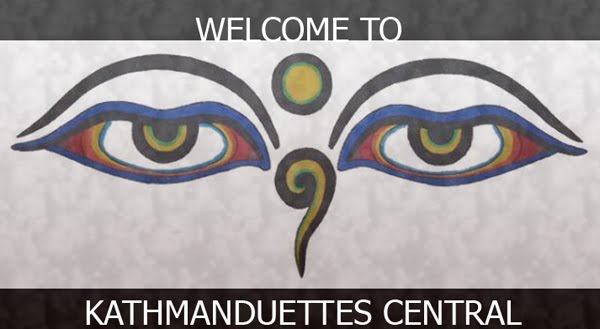Close to the furious-looking Kal Bhairab, some of the Kathmanduettes had a thangka suki who had a very small stall. He would drag his four battered tin trunks out in the sun to show us his ware. We purchased a number of thangkas from him, as his prices were right and had smaller sizes that make perfect presents. This suki also had good brocade framing. We had kept two of these purchases, the larger ones. There were a number of sari shops in the area. I still have some muslin or organdy sari remnants in a box somewhere, but I have run out of ideas what to do with them after making scarves, skirts or whatever they were good for. But I guess the favorite shops were those along the main road, the gem shops. One tiny one, opposite Gem Palace, had a wooden stool by the entrance, perpetually occupied by a mustachioed long-term resident German chap with one leg, and dispensed his gem consultations to us for free. We had bought smoky topaz cut and polished stones for 4 rupees a carat, orange topaz for 20 rupees. Their silverwork was good too. Gem Palace did our silver wedding bands, with our names, date of marriage and “Kathmandu” inscribed in Nepalese in the inside of the bands.
And who can forget Hanuman Dhoka, the Hanuman statue draped in a red cloak as Protector of this very large royal palace dedicated to Hindu deities. Only with the Shahs did the Narayanhiti Palace began to be the royal residence. The Big Bell, Kumari House. And the Toothache Tree! For some reason the Tibetan shops are clustered here, selling maroon felt, narrow bands of backstrap loom woven cotton of many colors, brocades for making shirts worn inside men’s traditional robes and women’s dress (chubas), yak butter churners, coral and turquoise
For some reason the erotic carvings were not much of interest because there were a lot of other ancient, interesting and fine buildings built from the fifteenth century, and features to take in.
In the earlier days, you could bump into John Sanday and his associates, taking down notes and photographing the temples and other structures, for the Unesco Newari architectural restoration project. The three-roofed Taleju Temple was established in the 1500s, in a typical Newari architectural style and is elevated on platforms that form a pyramid-like structure. In one of our wedding pictures, we have a chap stroking a rooster at the second platform, blowing smoke into the eyes with his bidi cigarette, to make him braver and fluff his feathers, thus perhaps more saleable.
Well, Nepal Bank established a branch inside the new UN Building at Pulchowk when it was completed. It was much more efficient, but took out the great joy of our leisurely wanderings about.
I am sure you will enjoy viewing a 3-D model, graphic 9 minute 47 second film on YouTube, on Durbar Square, by a Nepalese architect, Bishnu K. Shrestha. He says: "I dream of a time, when Kathmandu Durbar Square will be clean and cared for. At night, carefully placed spotlights bring out of the beauty of the ancient temples.The vision is recreated here."
http://www.youtube.com/watch?v=ANrEJ-F2LYs&feature=related















